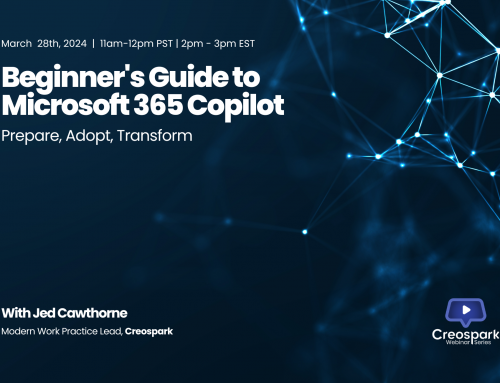Webinar Recap | Curating a Castle for your Copilot to Shine
In our recent webinar, we explored Generative AI and its key components, including Copilot, governance best practices, and data management strategies.
Our host, Jed Cawthorne, provided valuable insights into enhancing productivity through Copilot, establishing a robust Microsoft 365 Governance Plan, and training on AI governance decisions. These steps are crucial to ensuring optimal Copilot performance and access to accurate information for best results. Let’s delve deeper into the key takeaways from this enlightening session.
In this session
Understanding Copilot’s role
We began by drawing a fascinating analogy likening Copilot to medieval knights and their squires. Like a knight relies on a squire for support, Copilot is your AI-powered digital assistant or modern-day squire.

One notable tool highlighted was DALL-E, renowned for its ability to generate visually compelling images that enhance AI-driven presentations and content. However, it’s crucial to maintain a rational perspective—while Copilot significantly augments AI capabilities, they are not yet refined to replace humans. As we showcased medieval-themed images generated by DALL-E, we marveled at the pace of AI improvement but also acknowledged the need for human oversight and creativity.
Governance Best Practices
Transitioning to governance, Jed discussed the importance of setting up hard rules to manage Microsoft 365 Copilot AI. A key part of this is making or improving a detailed plan for Microsoft 365 Governance that follows AI rules.

This plan shows what data Copilot can use, helping team members know what’s allowed. Making this plan easy to find on the intranet is important so decisions can be made quickly and everyone knows what to do with Copilot. Also, teaching about governance when new users join is crucial for using AI responsibly.
Data Management Strategies
The key to making AI work well is having good data. We stressed the importance of managing data carefully to make Copilot work its best. This means using a variety of methods to handle data in the best way possible.
- Cleaning up data: Analyzing data for redundant, obsolete, or trivial files (ROT) streamlines Copilot’s processing efficiency, ensuring it focuses on relevant and actionable information.
- Organizing data structures: Implementing Information Architecture (IA) principles, such as structured document libraries and folders, lays a foundation for data security and permission management. This aids in determining which data Copilot can process, particularly sensitive or confidential information.
- Tagging metadata: Harnessing the power of metadata enriches data organization and aids Copilot in contextual understanding. Well-structured metadata provides additional signals and clues, enhancing Copilot’s response accuracy.
- Standardizing naming conventions: Consistent naming conventions offer clarity and relevance, enabling Copilot to discern the nature and relevance of files for more precise responses.
- Version control: Managing versions prevents Copilot from basing responses on outdated or irrelevant information, ensuring the accuracy and timeliness of AI-generated insights.
- Promoting good data practices: Educating team members on best practices in data management cultivates a data-conscious culture, aligning with Copilot’s need for high-quality inputs.
Summary
In this session, we discussed the purpose of Copilot in your work and governance and data management best practices. Companies must consider these aspects to make the most of AI while following responsible AI practices. If you’re looking for your next webinar, join us for an educational session on Microsoft SharePoint Premium 101 to get familiar with this advanced content management platform.
- SharePoint Premium Governance Features - May 22, 2024
- Webinar Recap | Microsoft SharePoint Premium 101 - May 14, 2024
- What you need to know about Microsoft SharePoint Premium - May 2, 2024
Related Posts
Subscribe our newsletter
Enter your email to get latest updates.
















